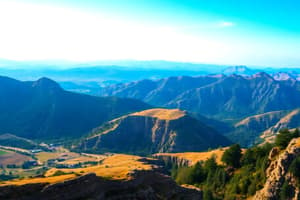Podcast
Questions and Answers
What is the primary purpose of Geographic Information Systems (GIS)?
What is the primary purpose of Geographic Information Systems (GIS)?
- To monitor satellite communications
- To store, analyze, and display geographic data (correct)
- To create physical models of geographic areas
- To study and interpret climate change patterns
Which activity is considered as fieldwork in geography?
Which activity is considered as fieldwork in geography?
- Conducting direct observation and data collection (correct)
- Creating digital models of landforms
- Performing statistical analysis on existing data
- Analyzing historical maps
How does geography contribute to understanding environmental issues?
How does geography contribute to understanding environmental issues?
- By focusing primarily on urban development
- By limiting analysis to historical records
- By examining the distribution and impact of natural resources (correct)
- By emphasizing political borders over natural landscapes
What human activities are significantly examined for their impacts on the environment?
What human activities are significantly examined for their impacts on the environment?
What is one of the crucial roles of geography in relation to global challenges?
What is one of the crucial roles of geography in relation to global challenges?
Which branch of geography focuses on the spatial patterns of human activities?
Which branch of geography focuses on the spatial patterns of human activities?
What does 'absolute location' refer to?
What does 'absolute location' refer to?
Which of the following concepts in geography pertains to the extent of an area or distribution of features?
Which of the following concepts in geography pertains to the extent of an area or distribution of features?
What is the main focus of Environmental Geography?
What is the main focus of Environmental Geography?
Which of the following is NOT a type of region in geography?
Which of the following is NOT a type of region in geography?
What is the purpose of Geographic Information Systems (GIS)?
What is the purpose of Geographic Information Systems (GIS)?
What influences the concept of globalization in geography?
What influences the concept of globalization in geography?
Which method in geography is primarily associated with collecting data about the Earth from a distance?
Which method in geography is primarily associated with collecting data about the Earth from a distance?
Flashcards
What are Geographic Information Systems or GIS?
What are Geographic Information Systems or GIS?
Tools used for storing, analyzing, and displaying geographic data.
What is Cartography?
What is Cartography?
The art and science involved in creating maps, depicting both natural and human features.
What is Fieldwork?
What is Fieldwork?
The practice of collecting data directly in the field, usually through observation, measurement, or surveying.
What is Data Analysis in Geography?
What is Data Analysis in Geography?
Signup and view all the flashcards
What is the focus of Human Impacts on the Environment?
What is the focus of Human Impacts on the Environment?
Signup and view all the flashcards
What is geography?
What is geography?
Signup and view all the flashcards
What is physical geography?
What is physical geography?
Signup and view all the flashcards
What is human geography?
What is human geography?
Signup and view all the flashcards
What is place?
What is place?
Signup and view all the flashcards
What is space in geography?
What is space in geography?
Signup and view all the flashcards
What is a region?
What is a region?
Signup and view all the flashcards
What is scale in geography?
What is scale in geography?
Signup and view all the flashcards
What is globalization?
What is globalization?
Signup and view all the flashcards
Study Notes
Introduction to Geography
- Geography is the study of the Earth's surface and the processes that shape it.
- It examines the spatial distribution of physical and human phenomena, and their interactions.
- Geography combines elements of both the natural and human sciences.
- It explores concepts of location, place, space, and region.
Branches of Geography
- Physical Geography: Focuses on the Earth's natural systems
- Includes topics like climate, landforms, hydrology, biogeography, soils, and atmosphere
- Human Geography: Examines the spatial patterns of human activities
- Addresses topics such as population, culture, economics, politics, and urban development
- Environmental Geography: Studies the interactions between human societies and their environment, often exploring environmental problems.
- Regional Geography: Studies the specific characteristics and patterns of particular places or regions.
Key Concepts in Geography
- Location: The position of a place on the Earth's surface.
- Absolute location: Specific coordinates (latitude and longitude).
- Relative location: Position in relation to other places.
- Place: The unique characteristics of a location, both physical and human.
- Includes physical features, culture, and history
- Space: The extent of an area or the distribution of features across an area.
- Spatial analysis looks at patterns and relationships in space.
- Region: An area with similar characteristics, such as climate, culture, or political system.
- Different types of regions, such as formal, functional, and vernacular regions exist
- Scale: The level of detail in a geographic analysis; from local to global.
- Interconnections: Physical and human geography are deeply connected, affecting each other and creating complex patterns
- Globalization: The increasing interconnectedness and interdependence of countries and cultures.
- GIS (Geographic Information Systems): Tools for analyzing and visualizing geographic data; including maps, satellite imagery, and databases.
Geographic Tools and Techniques
- Maps: Visual representations of the Earth's surface, displaying location, distribution, patterns, and relationships.
- Different map projections exist, each with its advantages and disadvantages.
- Remote Sensing: Collecting data about the Earth from a distance, using satellites, aircraft, or other technologies.
- Data processed and analyzed to understand Earth's surface.
- Geographic Information Systems (GIS): Tools to store, analyze, and display geographic data.
- Used to create maps, analyze spatial patterns, and solve problems related to location
- Cartography: The art and science of making maps.
- Fieldwork: Direct observation and collection of data in the field.
- Data analysis: Methods for examining and interpreting geographic data.
Environmental Issues in Geography
- Geography plays a crucial role in studying and addressing environmental issues.
- Examining how natural resources are distributed, utilized, and impacted by different activities.
- Understanding environmental problems (such as deforestation, pollution, climate change).
- Studying the spatial impacts, trends & patterns.
Human Impacts on the Environment
- Various human activities, affecting aspects like land use, resource extraction, and industrialization impact the environment.
- Examining how human actions contribute to environmental change.
Conclusion
- Geography provides a framework for understanding the world's diverse landscapes, processes, and people.
- Knowledge is crucial for sustainable development, environmental protection, and addressing global challenges.
Studying That Suits You
Use AI to generate personalized quizzes and flashcards to suit your learning preferences.




